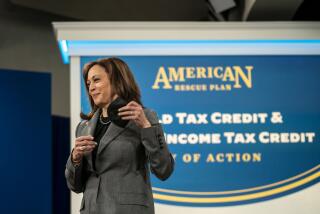Clinton’s Plans for Tax Cut Reaffirmed : Budget: An aide said the break to middle class will stay in the incoming President’s economic agenda out of ‘fairness.’
- Share via
LITTLE ROCK, Ark. — A top aide reaffirmed Wednesday that President-elect Bill Clinton plans to proceed with some form of a middle-class tax cut as part of his larger economic program.
At the same time, however, aides seemed intent on shifting attention from Clinton’s short-term economic goals to his longer-term solutions for the nation’s troubled economy.
The tax cut “needs to stay in (Clinton’s plans) because we saw in the 1980s that the tax system got out of whack,” Clinton communications director George Stephanopoulos said at his daily briefing.
During the 1980s, “the system became more polarized and more unequal,” he added, repeating Clinton’s stance that a “middle-class tax cut (is) one small down payment on fairness.”
None of the statements broke new ground. Instead, their significance lay in Stephanopoulos’ willingness to squelch speculation that Clinton might move away from his tax-cut proposal, which has met with resistance in some quarters. Some economists and conservatives fear that it would worsen the deficit, while many liberal Democrats argue the money that would be lost would be better spent on government programs.
As a highly visible campaign promise by Clinton, the proposed middle-class tax cut has taken on an importance far out of proportion to the actual dollars that might be involved. During the campaign, Clinton spoke of several tax-cut possibilities, ranging from an outright reduction in tax rates for some middle-income Americans to an expanded tax deduction for middle-income families with children. In all cases, the money involved was relatively small.
But given Clinton’s reputation as a politician who leaves escape clauses in every sentence, reporters and potential political opponents have been scrutinizing his words and those of his aides for any sign that he plans to renege on the tax-cut commitment.
Speculation that he might do so has increased with recent economic reports. New numbers seem to indicate that the economy is improving but they also suggest that the federal deficit may be worse than Clinton and his aides believed when they assembled their campaign economic plan in June.
Both of those factors would work against a tax cut. If the economy is improving, there would be no need for the economic stimulus that a tax cut might produce. And if the deficit is worse than believed, a tax cut would only complicate the business of reducing it.
Although Stephanopoulos’ statement appeared designed to end speculation about the future of the tax cut, it still leaves in doubt many key details: the size of a cut, which taxpayers would qualify for it and how quickly it might take effect.
In discussing the cut, Stephanopoulos noted that Clinton’s campaign statements referred to it as part of the long-term economic plan, a blueprint for actions over several years.
Overall, Clinton aides appeared to be trying to focus attention on that long-term plan, seeking to avoid raising expectations that Clinton’s short-term economic agenda would include any massive new spending programs.
Asked Wednesday about the agenda for the economic conference Clinton will host here later this month, for example, Stephanopoulos made a point of noting that Clinton had said he “wants to focus on his long-term plan.”
Some members of Congress and Washington interest groups have been concentrating on the possibility that Clinton would propose a large short-term economic stimulus plan that would open the way for new spending on a range of pet projects--everything from highway construction to environmental cleanup. Various Washington sources have touted plans with price tags as high as $50 billion for a year.
But while some Clinton advisers seemed to have supported plans of that magnitude in the past, opinion within the Clinton camp appears now to have shifted toward a far more modest short-term plan and greater emphasis on the long-term agenda.
That, of course, could change once again if the latest signs of economic recovery begin to disappear.
More to Read
Get the L.A. Times Politics newsletter
Deeply reported insights into legislation, politics and policy from Sacramento, Washington and beyond. In your inbox twice per week.
You may occasionally receive promotional content from the Los Angeles Times.











